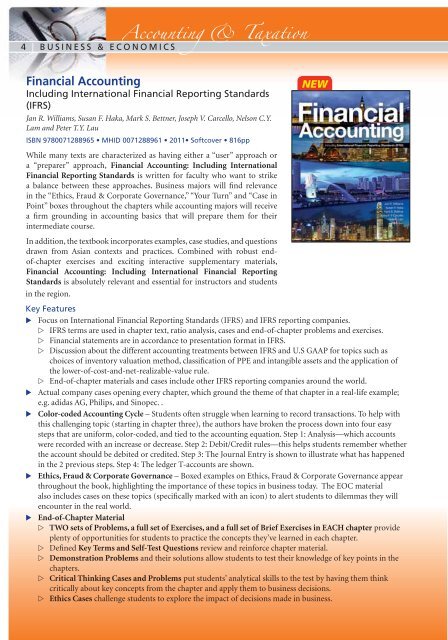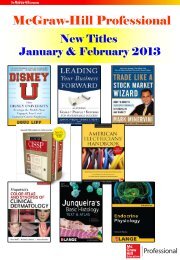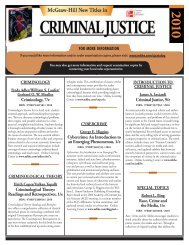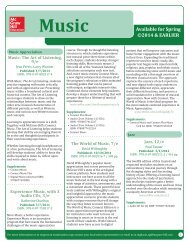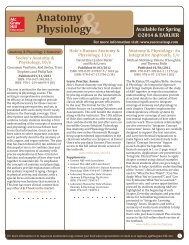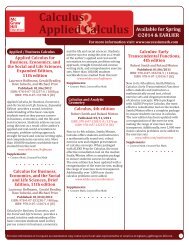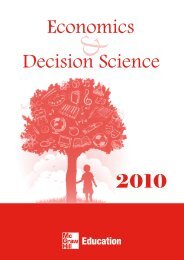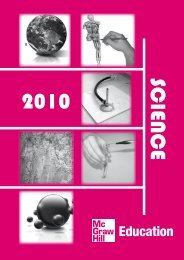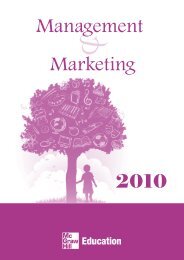Download - Mcgraw-hill.com.sg
Download - Mcgraw-hill.com.sg
Download - Mcgraw-hill.com.sg
- No tags were found...
Create successful ePaper yourself
Turn your PDF publications into a flip-book with our unique Google optimized e-Paper software.
4 | BUSINESS & ECONOMICS<br />
Financial Accounting<br />
Including International Financial Reporting Standards<br />
(IFRS)<br />
Jan R. Williams, Susan F. Haka, Mark S. Bettner, Joseph V. Carcello, Nelson C.Y.<br />
Lam and Peter T.Y. Lau<br />
ISBN 9780071288965 • MHID 0071288961 • 2011• Softcover • 816pp<br />
While many texts are characterized as having either a “user” approach or<br />
a “preparer” approach, Financial Accounting: Including International<br />
Financial Reporting Standards is written for faculty who want to strike<br />
a balance between these approaches. Business majors will find relevance<br />
in the “Ethics, Fraud & Corporate Governance,” “Your Turn” and “Case in<br />
Point” boxes throughout the chapters while accounting majors will receive<br />
a firm grounding in accounting basics that will prepare them for their<br />
intermediate course.<br />
In addition, the textbook incorporates examples, case studies, and questions<br />
drawn from Asian contexts and practices. Combined with robust endof-chapter<br />
exercises and exciting interactive supplementary materials,<br />
Financial Accounting: Including International Financial Reporting<br />
Standards is absolutely relevant and essential for instructors and students<br />
in the region.<br />
NEW<br />
Key Features<br />
Focus on International Financial Reporting Standards (IFRS) and IFRS reporting <strong>com</strong>panies.<br />
IFRS terms are used in chapter text, ratio analysis, cases and end-of-chapter problems and exercises.<br />
Financial statements are in accordance to presentation format in IFRS.<br />
Discussion about the different accounting treatments between IFRS and U.S GAAP for topics such as<br />
choices of inventory valuation method, classification of PPE and intangible assets and the application of<br />
the lower-of-cost-and-net-realizable-value rule.<br />
End-of-chapter materials and cases include other IFRS reporting <strong>com</strong>panies around the world.<br />
Actual <strong>com</strong>pany cases opening every chapter, which ground the theme of that chapter in a real-life example;<br />
e.g. adidas AG, Philips, and Sinopec. .<br />
Color-coded Accounting Cycle – Students often struggle when learning to record transactions. To help with<br />
this challenging topic (starting in chapter three), the authors have broken the process down into four easy<br />
steps that are uniform, color-coded, and tied to the accounting equation. Step 1: Analysis—which accounts<br />
were recorded with an increase or decrease. Step 2: Debit/Credit rules—this helps students remember whether<br />
the account should be debited or credited. Step 3: The Journal Entry is shown to illustrate what has happened<br />
in the 2 previous steps. Step 4: The ledger T-accounts are shown.<br />
Ethics, Fraud & Corporate Governance – Boxed examples on Ethics, Fraud & Corporate Governance appear<br />
throughout the book, highlighting the importance of these topics in business today. The EOC material<br />
also includes cases on these topics (specifically marked with an icon) to alert students to dilemmas they will<br />
encounter in the real world.<br />
End-of-Chapter Material<br />
TWO sets of Problems, a full set of Exercises, and a full set of Brief Exercises in EACH chapter provide<br />
plenty of opportunities for students to practice the concepts they’ve learned in each chapter.<br />
Defined Key Terms and Self-Test Questions review and reinforce chapter material.<br />
Demonstration Problems and their solutions allow students to test their knowledge of key points in the<br />
chapters.<br />
Critical Thinking Cases and Problems put students’ analytical skills to the test by having them think<br />
critically about key concepts from the chapter and apply them to business decisions.<br />
Ethics Cases challenge students to explore the impact of decisions made in business.


